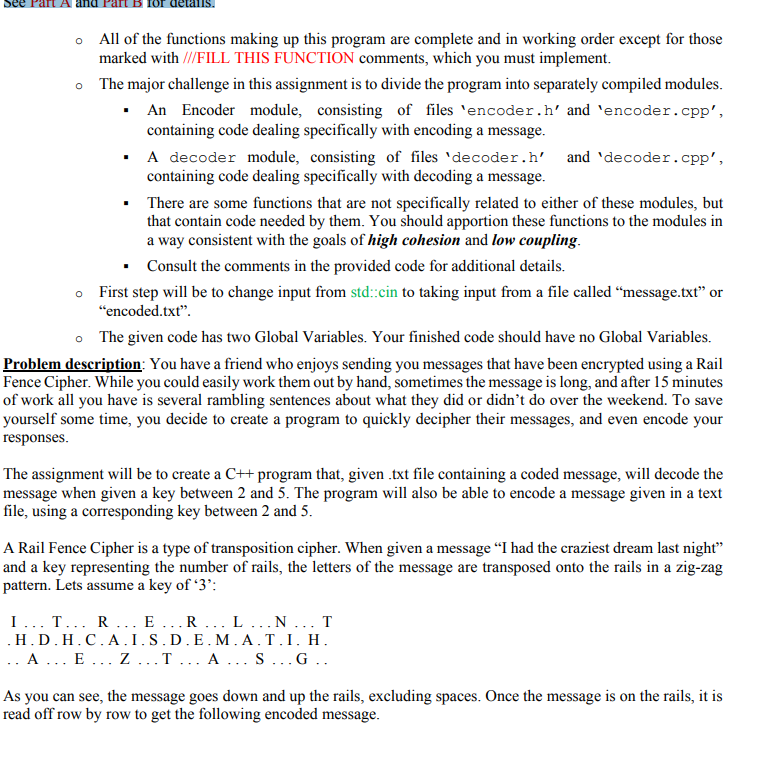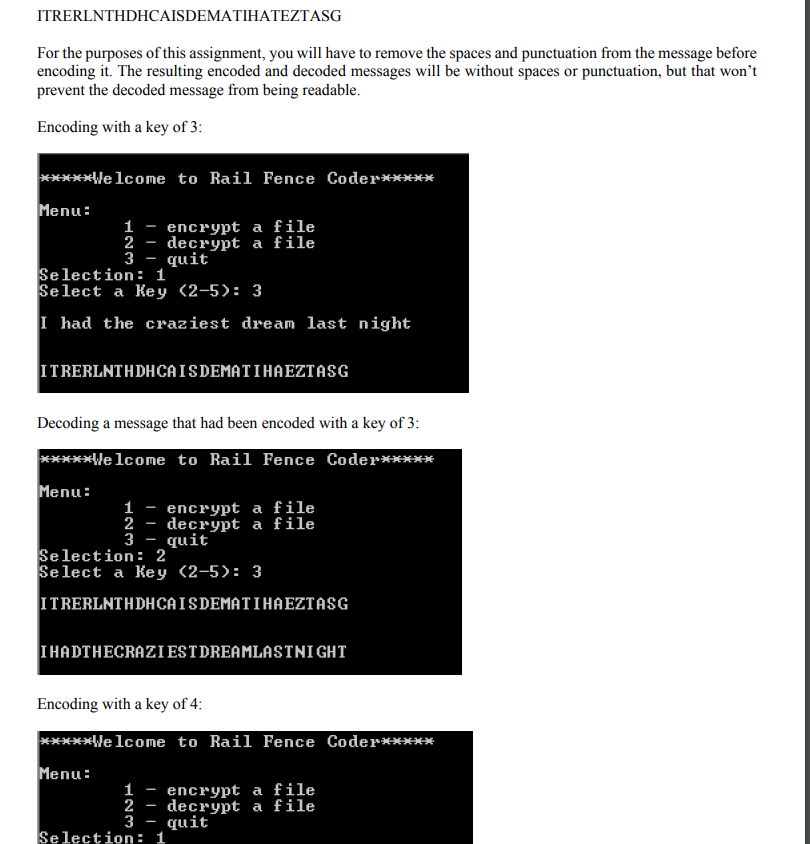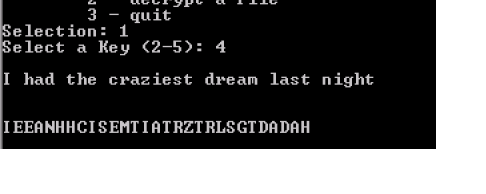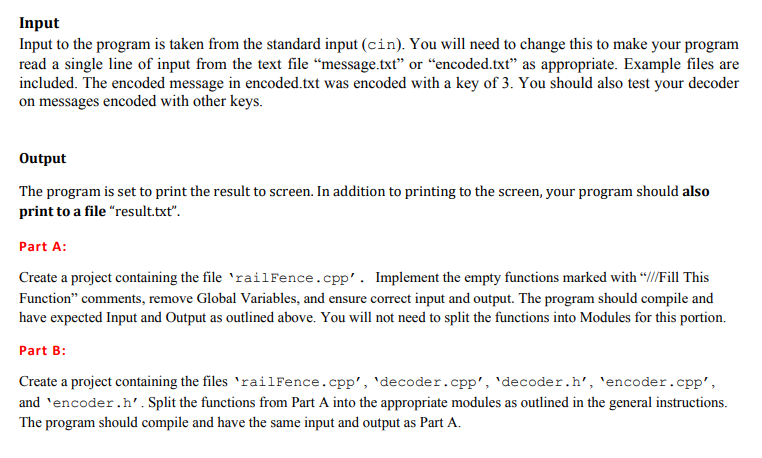Question
General Instructions: Read the problem description below and implement this program in C++. The files for this assignment are provided under the folder for this
General Instructions: Read the problem description below and implement this program in C++. The files for this assignment are provided under the folder for this assignment. You will be submitting two separate projects. See Part A and Part B for details.




From 'railFence.cpp'
#include #include #include "encoder.h" #include "decoder.h"
std::string msg; int key;
///Determines the number of letters on each rail, given a key and an encoded message, and separates ///the encoded message into an array of size key, representing the rails. The length of the cycle ///must be determined, along with the size of the remainder representing an unfinished cycle. void splitEncoded( std::string strarray[]){ int cycle= (2 * key)-2; int div=cycle; int len=msg.length(); int remainder=0; int pos=0; for(int i=0; i int counter=((len)/div);
if(cycle!=0 && remainder!=0){ counter= 2*counter; if((len%div)>=(div-(i-1))){ counter+=2; } else if((len%div)>i){ counter++; } } else if(((len)%div)>i){ counter++; }
strarray[i]=msg.substr(pos,counter); pos+=counter; cycle=cycle-2; remainder+=2;
}
}
///Takes the filled array representing the rails and cycles down and up to ///to retrieve the chars in the correct order, building the decoded /// message. std::string concatDecoded( std::string strarray[], int len){ std::string decodedMsg; int counter=0;
while(counter for(int i=0; i if(counter==len){ return decodedMsg; } decodedMsg+=strarray[i][0]; if(strarray[i].length()>1) strarray[i]=strarray[i].substr(1); else strarray[i]=""; ++counter;
} for(int i=key-2; i>0; i--){ if(counter==len){ return decodedMsg; } decodedMsg+=strarray[i][0]; if(strarray[i].length()>1) strarray[i]=strarray[i].substr(1); else strarray[i]=""; ++counter;
} } return decodedMsg; }
///returns a char converted to Uppercase
char toUpperCase (char c) { ///FILL THIS FUNCTION: converts char c to UPPER CASE and returns UPPER CASE.
return c; };
///Return true if char is alpha numeric
bool isAlphanumeric (char c) { ///FILL THIS FUNCTION: evaluates char c, returns true if c is Alphanumeric (0-9, A-Z, a-z)
return true;///this is just a place holder for your return statement. };
///Given an uncoded message and an array representing the rails ///cycles down and up the rails, filling the array until message ends void splitMessage( std::string strarray[]){ int counter=0;
while(counter for(int i=0; i strarray[i]+= msg[counter]; ++counter; if(counter==msg.length()) return; } for(int i=key-2; i>0; i--){ strarray[i]+= msg[counter]; ++counter; if(counter==msg.length()) return; } }
};
///given a filled array representing the rails, concatenates the ///strings on the rails and returns a coded message std::string concatEncoded(std::string strarray[]){ ///FILL THIS FUNCTION: given an array of strings representing the rails, ///and the size of the array, ///concatenate the strings into a single string representing the encoded message and ///return it.
return "this is an encoded message";///this is just a place holder for your return statement }
///given a message, formats the message for encoding or decoding void prepmessage(){ ///FILL THIS FUNCTION: given a message, converts message to all ///uppercase and removes non-alphanumeric characters including spaces ///and punctuation. Notice this is a VOID function!!!
} ///makes functions calls for encoding a message void encodeMessage(){ prepmessage(); std::string encoded[key];//an array representing the rails splitMessage(encoded); msg=concatEncoded(encoded);
};
///makes function calls to decode a coded message void decodeMessage(){ std::string decoded[key];//an array representing the rails splitEncoded(decoded); msg=concatDecoded( decoded, msg.length()); }
///********************************************** ///EVERYTHING BELOW THIS LINE REMAINS IN RAILFENCE.CPP ///**********************************************
///reads message from file stream in
std::string readMessage(std::istream& in) { std::string inmsg; std::string line; getline (in, line); while (in) { inmsg = inmsg + line + " "; getline (in, line); }
return inmsg; }
///given an out stream, prints the message
void printMessage(std::ostream& out){ out
}
///promps the user for a KEY 2-5
int getKey(){ int newkey; while(true){ std::cout>newkey){ if(newkey>1 && newkey
///prints a menu and asks the user for a selection
char getselection(){ std::string selection="0"; std::cin.clear(); while(selection[0]'3'){ std::cout
getline(std::cin, selection);
if(selection[0]'3'){ std::cout
int main() { bool quit=false; while(!quit){ char select=getselection(); switch(select){ case '1': key = getKey(); msg=readMessage(std::cin); printMessage(std::cout); encodeMessage(); printMessage(std::cout); break;
case '2': key = getKey(); msg=readMessage(std::cin); printMessage(std::cout); prepmessage(); decodeMessage(); printMessage(std::cout); break;
case '3': std::cout
} }
return 0; }
From 'encoder.cpp'
#include "encoder.h"
From 'decoder.cpp'
#include "decoder.h"
From 'encoder.h'
#ifndef __ENCODER_H__ #define __ENCODER_H__
#endif // __ENCODER_H__
From 'decoder.h'
#ifndef __DECODER_H__ #define __DECODER_H__
#endif // __DECODER_H__
bee All of the functions making up this program are complete and in working order except for those marked with //FILL THIS FUNCTION comments, which you must implement. The major challenge in this assignment is to divide the program into separately compiled modules. An Encoder module, consisting of files 'encoder.h' and 'encoder.cpp', containing code dealing specifically with encoding a message. A decoder module, consisting of files 'decoder.h' and 'decoder.cpp', containing code dealing specifically with decoding a message. There are some functions that are not specifically related to either of these modules, but that contain code needed by them. You should apportion these functions to the modules in a way consistent with the goals of high cohesion and low coupling. Consult the comments in the provided code for additional details. First step will be to change input from std::cin to taking input from a file called message.txt or "encoded.txt. o The given code has two Global Variables. Your finished code should have no Global Variables. Problem description: You have a friend who enjoys sending you messages that have been encrypted using a Rail Fence Cipher. While you could easily work them out by hand, sometimes the message is long, and after 15 minutes of work all you have is several rambling sentences about what they did or didn't do over the weekend. To save yourself some time, you decide to create a program to quickly decipher their messages, and even encode your responses. The assignment will be to create a C++ program that, given txt file containing a coded message, will decode the message when given a key between 2 and 5. The program will also be able to encode a message given in a text file, using a corresponding key between 2 and 5. A Rail Fence Cipher is a type of transposition cipher. When given a message I had the craziest dream last night and a key representing the number of rails, the letters of the message are transposed onto the rails in a zig-zag pattern. Lets assume a key of '3': I ...T... R ...E...R... L ...N ... T .H.D.H.C.A.I.S.D.E.M.A.T.I.H. ..A... E... Z ...T... A...S...G.. As you can see, the message goes down and up the rails, excluding spaces. Once the message is on the rails, it is read off row by row to get the following encoded message. ITRERLNTHDHCAISDEMATIHATEZTASG For the purposes of this assignment, you will have to remove the spaces and punctuation from the message before encoding it. The resulting encoded and decoded messages will be without spaces or punctuation, but that won't prevent the decoded message from being readable. Encoding with a key of 3: *****Welcome to Rail Fence Coder***** Menu: 1 - encrypt a file 2 decrypt a file 3 quit Selection: 1 Select a key (2-5): 3 I had the craziest dream last night ITRERLNTHDHCAISDEMATIHAEZTASG Decoding a message that had been encoded with a key of 3: *****Welcome to Rail Fence Coder***** Menu: 1 - encrypt a file 2 decrypt a file 3 quit Selection: 2 Select a key (2-5): 3 ITRERLNTHDHCAISDEMATIHAEZTASG IHADTHECRAZIESTDREAMLASTNIGHT Encoding with a key of 4: *****Welcome to Rail Fence Coder***** Menu: 1 encrypt a file 2 - decrypt a file 3 - quit Selection: 1 3 - quit Selection: 1 Select a Key (2-5): 4 I had the craziest dream last night I EEANHHCI SEMTIATRZTRLSGT DADAH Input Input to the program is taken from the standard input (cin). You will need to change this to make your program read a single line of input from the text file message.txt or encoded.txt" as appropriate. Example files are included. The encoded message in encoded.txt was encoded with a key of 3. You should also test your decoder on messages encoded with other keys. Output The program is set to print the result to screen. In addition to printing to the screen, your program should also print to a file "result.txt". Part A: Create a project containing the file 'railFence.cpp'. Implement the empty functions marked with /Fill This Function comments, remove Global Variables, and ensure correct input and output. The program should compile and have expected Input and Output as outlined above. You will not need to split the functions into Modules for this portion. Part B: Create a project containing the files 'railFence.cpp', 'decoder.cpp', 'decoder.h', 'encoder.cpp', and 'encoder.h'. Split the functions from Part A into the appropriate modules as outlined in the general instructions. The program should compile and have the same input and output as Part AStep by Step Solution
There are 3 Steps involved in it
Step: 1

Get Instant Access to Expert-Tailored Solutions
See step-by-step solutions with expert insights and AI powered tools for academic success
Step: 2

Step: 3

Ace Your Homework with AI
Get the answers you need in no time with our AI-driven, step-by-step assistance
Get Started


